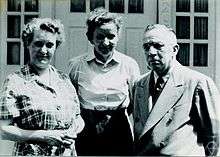John Robert Kline
John Robert Kline (December 7, 1891 – May 2, 1955)[1] was an American mathematician and educator.
John Robert Kline | |
|---|---|
 John Robert Kline (right) | |
| Born | December 7, 1891 Quakertown, Pennsylvania, U.S. |
| Died | May 2, 1955 (aged 63) Quakertown, Pennsylvania, U.S. |
| Nationality | United States |
| Alma mater | University of Pennsylvania |
| Known for | Kline sphere characterization |
| Scientific career | |
| Fields | Mathematics |
| Institutions | University of Pennsylvania |
| Doctoral advisor | R. L. Moore |
| Doctoral students | |
One of three children born to Henry K. Kline (1862–1923) and Emma M. Kline (1869–1948), he was Professor of Mathematics at the University of Pennsylvania from 1920-55. A Ph.D. student of Robert Lee Moore, he was a Guggenheim Fellow in 1925, later Chairman of the Department of Mathematics from 1933-54, and Thomas A. Scott Professor of Mathematics from 1941-55.[2]
His doctoral students include Lida Barrett, Arthur Milgram, Athanasios Papoulis, Dudley Weldon Woodard, Leo Zippin,[3] and William Waldron Schieffelin Claytor.[4]
Partial bibliography
- John Robert Kline (1919). "Concerning Sense on Closed Curves in Non-Metrical Plane Analysis Situs". The Annals of Mathematics. Annals of Mathematics. 21 (2): 113–119. doi:10.2307/2007227. JSTOR 2007227.
- John Robert Kline (January 1923). "Closed Connected Sets Which Are Disconnected by the Removal of a Finite Number of Points". Proc Natl Acad Sci USA. 9 (1): 7–12. doi:10.1073/pnas.9.1.7. PMC 1085211. PMID 16586914.
- John Robert Kline (May 1924). "Concerning the Division of the Plane by Continua". Proc Natl Acad Sci USA. 10 (5): 176–177. doi:10.1073/pnas.10.5.176. PMC 1085587. PMID 16576811.
- John Robert Kline (1927). "Concerning the sum of a countable infinity of mutually exclusive continua". Mathematische Zeitschrift. 26: 687. doi:10.1007/BF01475482.
gollark: I mean, you can get, what, 224 cores in a server now, but it's horrendously expensive.
gollark: <@451887563603574784> How do you have THAT EXPENSIVE a server?
gollark: It would, but briefly.
gollark: Ring-directly-adjacent-to-core.
gollark: Max 24.
References
- "John Robert Kline (1891-1955) - Find A Grave..." findagrave.com. Retrieved July 10, 2020.
- "RANK AND FILE AMERICAN MATHEMATICIANS" (PDF). math.temple.edu. Retrieved 2020-07-10.
- The Legacy of R. L. Moore, The Students of R. L. Moore — Ben Fitzpatrick, Jr., legacyrlmoore.org; accessed July 9, 2020.
- William W. Schieffelin Claytor at the Mathematical Association of America
External links
This article is issued from Wikipedia. The text is licensed under Creative Commons - Attribution - Sharealike. Additional terms may apply for the media files.